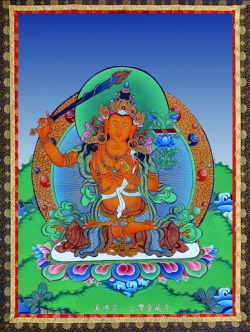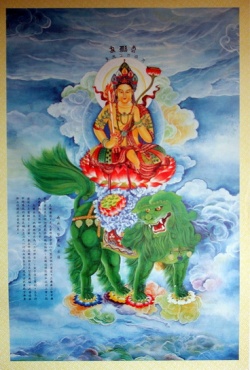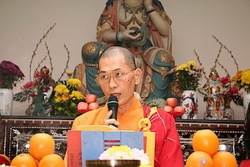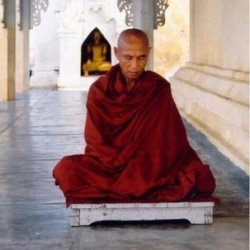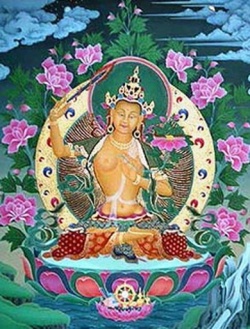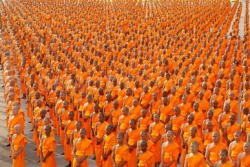Cārvāka
Cārvāka (Sanskrit: चार्वाक), also known as Lokāyata, is a system of Indian philosophy that assumes various forms of philosophical skepticism and religious indifference. Etymologically, both words Cārvāka and Lokāyata mean "popular" or "agreeable" in Sanskrit.
Cārvāka is classified as a heterodox Hindu (Nāstika) system. It is characterized as a materialistic and atheistic school of thought. While this branch of Indian philosophy is today not considered to be part of the six orthodox schools of Hindu philosophy, some describe it as an atheistic or materialistic philosophical movement within Hinduism.
Cārvāka emerged as an alternative to the orthodox Hindu pro-Vedic Āstika schools, as well as a philosophical predecessor to subsequent or contemporaneous nāstika philosophies such as Ājīvika, Jainism and Buddhism (the latter two later spinning off into what may be described today as separate religions) in the classical period of Indian philosophy. As opposed to other schools, the first principle of Cārvāka philosophy was the rejection of inference as a means to establish metaphysical truths.
Name
Etymologically, Cārvāka means "agreeable speech" (cāru – agreeable and vāk – speech) and Lokāyata signifies "prevalence in the world" (loka – world and āyata – prevalent).
The name Lokāyata can be traced to Kautilya's Arthashastra, which refers to three ānvīkṣikīs (logical philosophies) — Yoga, Samkhya and Lokāyata. However, Lokāyata in Arthashastra, does not stand for materialism because the Arthashastra refers to Lokāyata as a part of Vedic lore. Lokāyata here probably refers to logic or science of debate (disputatio, "criticism") and not to the materialist doctrine. Similarly, Saddaniti and Buddhaghosa in the 5th century connect the "Lokāyata" with the Vitandas (sophists).
It is only from about the 6th century that the term Lokāyata was restricted to the school of the materialists or Lokyātikas. The name Cārvāka was first used in the 7th century by the philosopher Purandara, who referred to his fellow materialists as "the Cārvākas", and it was used by the 8th century philosophers Kamalaśīla and Haribhadra. Adi Shankara, on the other hand, always used Lokāyata, not Cārvāka. By the 8th century, the terms Cārvāka, Lokāyata, and Bārhaspatya were used interchangeably to signify materialism.
Origin
The earliest documented materialist in India is Ajita Kesakambali, a senior contemporary of the Buddha (sixth/fifth century BCE). The basic tenets of Cārvāka philosophy, of no soul and existence of four (not five) elements were probably inspired from him. Although materialist schools existed before Cārvāka, it was the only school which systematized materialist philosophy by setting them down in the form of aphorisms in the 6th century. There was a base text, a collection sūtras or aphorisms and several commentaries were written to explicate the aphorisms.
E. W. Hopkins, in his The Ethics of India (1924) claims that Cārvāka philosophy was contemporaneous to Jainism and Buddhism, mentioning "the old Cārvāka or materialist of the 6th century BC". Rhys Davids assumes that lokāyata in ca. 500 BC came to mean "skepticism" in general without yet being organized as a philosophical school, and that the name of a villain in the epic Mahabharata, Cārvāka, was attached to the position in order to disparage it. The earliest positive statement of skepticism is preserved from the epic period, in the Ramayana, Ayodhya kanda, chapter 108, where Jabāli tries to persuade Rāma to accept the kingdom by using nāstika arguments (but Rāma then refutes him in chapter 109):
O, the highly wise! Arrive at a conclusion, therefore, that there is nothing beyond this Universe. Give precedence to that which meets the eye and turn your back on what is beyond our knowledge. (2.108.17)
The Cārvāka school thus appears to have gradually grown out of generic skepticism in the Mauryan period, but its existence as an organized body cannot be ascertained for times predating the 6th century. The Barhaspatya sutras were likely also composed in Mauryan times, predating 150 BC, based on a reference in the Mahabhasya of Patanjali's (7.3.45). Cārvāka was a living philosophy up to the 12th century AD after which this system seems to have disappeared without leaving any trace. The reason for this sudden disappearance is not known.
Earliest descriptions
Brihaspati is sometimes referred to as the founder of Cārvāka or Lokāyata philosophy. The earliest direct quote from Brihaspati's lost writings is found in the text Sarvasiddhantasamgraha, which is sometimes controversially attributed to Shankara. In the Sarvasiddhantasamgraha, the author quotes Brihaspati as follows:
“ Chastity and other such ordinances are laid down by clever weaklings; gifts of gold and land, the pleasure of invitations to dinner, are devised by indigent people with stomachs lean with hunger.
The building of temples, houses for water-supply, tanks, wells, resting places, and the like, please only travelers, not others.
The Agnihotra ritual, the three Vedas, the triple staff, the ash-smearing, are the ways of gaining a livelihood for those who are lacking in intellect and energy.
The wise should enjoy the pleasures of this world through the more appropriate available means of agriculture, tending cattle, trade, political administration, etc. ”
Philosophy
The Cārvāka school of philosophy had a variety of atheistic and materialistic beliefs. They held perception to be the only valid source of knowledge.
Epistemology
In syllogism, the middle term, which is found in both the subject (minor term) and is invariably connected with the predicate (major term), is seen as the cause of knowledge. This invariable connection between middle term and predicate is unconditional and causes inference not by virtue of its existence, like the existence of the eye is the cause of perception, but by virtue of it being known. To the Cārvākas there were no reliable means by which this connection could be known and therefore the efficacy of inference as a means of knowledge could not be established.
To prove that inference was not a reliable means of knowledge Cārvākas examined and refuted each of the various means of knowing the connection between the middle term and the predicate individually:
External perception, or perception which involves the use of the senses, could not be the required means because although, it is possible that the actual contact of the senses and the object could produce the knowledge of the particular object, yet there can never be such contact in the case of the past or the future. Therefore if external perception were the means on knowing the connection then inference related to objects of the past and future could not happen.
Internal perception, or perception which involves the mind could, not be the required means either, because one cannot establish that the mind has any power to act independently towards an external object and is thought to be dependent on the external senses.
Nor could inference be the means, since if inference were the proof of inference, one would also require another inference to establish this inference, and so on, leading to the fallacy of an Ad infinitum regression.
Nor could testimony be the means, since testimony can be classified as a type of inference. Moreover, there is no reason for one to believe word of another. Besides, if testimony were to be accepted as the only means of the knowledge of the invariable connection between middle term and predicate, then in the case of a man to whom the fact of the connection had not been pointed out by another person, there could be no inference.
Comparison (Upamana) could also be rejected as the means of the knowledge of the connection, since objective of using Upamana is to establish a different kind of knowledge than is being sought here, the relation of a name to something so named.
Absence of a condition (Upadhi), which is given as the definition of an invariable connection to restrict too general a middle term, could itself not be used to establish inference because it is impossible to establish that all conditions required to restrict the middle term are known without recourse to inference and inference, as has been proven earlier, cannot establish itself.
Metaphysics
Since, none of the means of knowing were found to be worthy to establish the invariable connection between middle term and predicate, Cārvākas concluded that the inference could not be used to ascertain metaphysical truths. Thus, to Cārvākas, the step which the mind takes from the knowledge of something to infer the knowledge of something else, could be accounted for by the its being based on a former perception or by its being in error. Cases where inference was justified by the result, were seen only to be mere coincidences.
Therefore, Cārvākas denied metaphysical concepts like reincarnation, extracorporeal soul, efficacy of religious rites, other world (heaven and hell), fate and accumulation of merit or demerit through the performance of certain actions. Cārvākas also rejected the use of supernatural causes to describe natural phenomena. To them all natural phenomena was produced spontaneously from the inherent nature of things.
The fire is hot, the water cold, refreshing cool the breeze of morn;
By whom came this variety ? from their own nature was it born.
Consciousness and Afterlife
Carvakas thought that body was formed out of four elements (instead of five) and that consciousness was an outcome of the mixture of these elements. Therefore, Carvakas did not believe in an afterlife. To them, all attributes that represented a person, such a thinness, fatness etc., resided in the body. To support the proposition of non-existence of any soul or consciousness in the afterlife Carvakas often quoted from Brihadaranyaka Upanishad.
Springing forth from these elements itself
solid knowledge is destroyed
when they are destroyed—
after death no intelligence remains.
The berries of paddy, rich with the finest white grains,
What man, seeking his true interest, would fling away because covered with husk and dust?
Religion
Cārvākas rejected religious conceptions like afterlife, reincarnation, religious rites etc. They were extremely critical of the Vedas and thought that Vedas suffered from three faults - untruth, self-contradiction and tautology. To them, Vedas were just incoherent rhapsodies. They also held the belief that such texts were invented and made up by men and had no divine authority.
The Agnihotra, the three Vedas, the ascetic's three staves, and smearing one's self with ashes,
Were made by Nature as the livelihood of those destitute of knowledge and manliness.
Criticism
Buddhist philosophers reasoned that the Cārvāka proposition that inference could not be used as a form of evidence (Pramana) was absurd. If no arguments were given to prove this proposition, it would just be a bare assertion. Whereas, if some form of argumentation were given, it would result in absurdity, because inference was being used to disprove its own efficacy as evidence. Besides, when existence of any object, be it the authority of inference, was denied on the ground of it not being perceived, inference was itself admitted in proposing such an argument, with middle term being the non-perception.
Works
No independent works on Cārvāka philosophy can be found except for a few sūtras composed by Brihaspati. The 8th century Tattvopaplavasimha of Jayarashi Bhatta (ca. 8th century) is often cited as the only extant authentic Cārvāka text, but which also shows Madhyamaka influence. Shatdarshan Samuchay and Sarvadarśanasaṅ̇graha of Vidyaranya are a few other works which elucidate Cārvāka thought.
One of the most important references to the Cārvāka philosophy is the Sarva-darśana-saṅgraha (etymologically all-philosophy-collection), a famous work of 14th century Advaita Vedanta philosopher Mādhava Vidyāraṇya from South India, which starts with a chapter on the Cārvāka system. After invoking, in the Prologue of the book, the Hindu gods Shiva and Vishnu ("by whom the earth and rest were produced"), Vidyāraṇya asks, in the first chapter:
“ ...but how can we attribute to the Divine Being the giving of supreme felicity, when such a notion has been utterly abolished by Charvaka, the crest-gem of the atheistic school, the follower of the doctrine of Brihaspati? The efforts of Charvaka are indeed hard to be eradicated, for the majority of living beings hold by the current refrain:
While life is yours, live joyously;
None can escape Death's searching eye:
When once this frame of ours they burn,
How shall it e'er again return?
”
Ain-i-Akbari, written by Abul Fazl, the famous historian of Akbar's court, mentions a symposium of philosophers of all faiths held in 1578 at Akbar's insistence. Some of the beliefs of Cārvāka are recorded from this symposium, in which, some Cārvāka philosophers are said to have participated.
Sanskrit poems and plays like the Naiṣadha-carita, Prabodha-candrodaya, Āgama-dambara, Vidvanmoda-taraṅgiṇī and Kādambarī contain representations of the Cārvāka thought. However, the authors of these works were thoroughly opposed to materialism and tried to portray the Cārvāka in unfavourable light. Therefore, their works should only be accepted critically.
Loss of original works
There was no continuity in the Cārvāka tradition after the 12th century. Whatever is written on Cārvāka post this is based on second-hand knowledge, learned from preceptors to disciples and no independent works on Cārvāka philosophy can be found. Chatterjee and Datta explain that our understanding of Cārvāka philosophy is fragmentary, based largely on criticism of its ideas by other schools, and that it is not a living tradition:
"Though materialism in some form or other has always been present in India, and occasional references are found in the Vedas, the Buddhistic literature, the Epics, as well as in the later philosophical works we do not find any systematic work on materialism, nor any organised school of followers as the other philosophical schools possess. But almost every work of the other schools states, for refutation, the materialistic views. Our knowledge of Indian materialism is chiefly based on these."
Representation of Cārvāka in Āstika, Buddhist and Jain Literature
The Yogācāra Buddhists, Jains, Advaita Vedantins and Nyāya philosophers considered the Cārvākas as one of their opponents and tried to refute their views. These refutations are sources of Cārvāka philosophy since, they continued to be made even after all the authentic Cārvāka/Lokāyata texts had been lost. However, the representation of the Cārvāka thought in these works is not always firmly grounded in first hand knowledge of Cārvāka texts and should be viewed critically.
Though Cārvākas accepted direct perception as the surest method to prove the truth of anything, they might also have accepted a limited usage of inference. The perception that Cārvākas had a rigid stance against the application of inference might have been a result of caricaturing of their arguments by their opponents. Debiprasad Chattopadhyaya quotes S. N. Dasgupta:
"Purandara (a Lokāyata philosopher) [...] admits the usefulness of inference in determining the nature of all worldly things where perceptual experience is available; but inference cannot be employed for establishing any dogma regarding the transcendental world, or life after death or the law of karma which cannot be available to ordinary perceptual experience."
Likewise, the charge of hedonism against Cārvāka might have been exaggerated. Countering the argument that the Cārvākas opposed all that was good in the Vedic tradition, Dale Riepe says, "It may be said from the available material that Cārvākas hold truth, integrity, consistency, and freedom of thought in the highest esteem."
